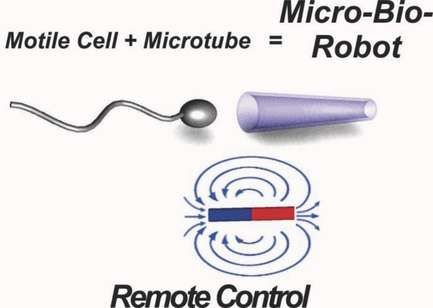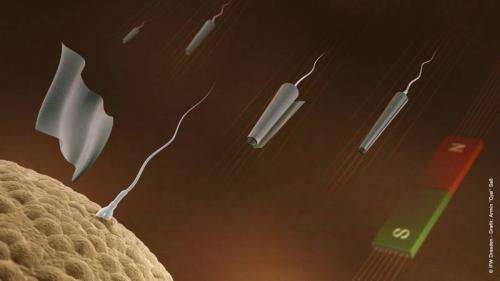January 17, 2014 weblog
Sperm-bots are made to move in desired direction (w/ Video)

Scientists have shown how controlled sperm cells inside tubes can be driven to target destinations using magnetic control. The significance of their investigation lies partly in what may be in store for in vitro fertilization. "Eventually," said a report in New Scientist, "these biobots could be used to shepherd individual sperm to eggs or to deliver targeted doses of drugs." The researchers, from the Institute for Integrative Nanosciences (IIN) in Dresden, Germany, demonstrated how remote-controlled "sperm-bots" can be used to fertilize eggs. A paper on their work was published last month in Advanced Materials and the topic continues to draw interest in this month's technology and science news sites. The December paper, "Development of a Sperm-Flagella Driven Micro-Bio-Robot," is by Veronika Magdanz, Samuel Sanchez, and Oliver G. Schmidt. They developed "a new biohybrid micro-robot" by capturing bovine sperm cells inside tubes that used the motile cells as the driving force. An external magnetic field controlled the robots.
Schmidt, the Institute's director, and his IIN colleagues combined the cells with magnetic metal tubes. Basically, the investigation involved live flagella from bull sperm to maneuver nanotubes in a desired direction using magnets. Changes in temperature were able to control their speeds.
According to a report on their work in Gizmag, the team intends to try assisted fertilization with animals before starting experiments with human sperm. One additional possibility is that their research might impact future investigations in targeted drug delivery, where drugs may be ferried along within the body.
Another interesting feature about this research is how it involves use of "biobots" as opposed to artificial engines. As Gizmag noted, a concern in research is that a nanobot intended to move through bodily fluids should not be toxic to the human body and should not cause harm to cells, affecting their functioning. The IIN scientists discussed safe "nano-engine" alternatives, or suitable "biorobots."

They opted for biorobots made of sperm cells and turned to bull sperm cells, Schmidt said, according to New Scientist, that reasons why sperm cells were an attractive choice were that they were harmless to the body, they could swim through viscous liquids, and they did not need any external power source. The researchers produced microtubes and worked with thawed-out bull sperm cells, remaining viable for several hours. According to New Scientist, the microtubes are made from iron and titanium nanoparticles.
More information: Press release in German
Paper: Development of a Sperm-Flagella Driven Micro-Bio-Robot, Advanced Materials, DOI: 10.1002/adma.201302544
Abstract
A new biohybrid micro-robot is developed by capturing bovine sperm cells inside magnetic microtubes that use the motile cells as driving force. These micro-bio-robots can be remotely controlled by an external magnetic field. The performance of micro-robots is described in dependence on tube radius, cell penetration, and temperature. The combination of a biological power source and a microdevice is a compelling approach to the development of new microrobotic devices with fascinating future applications.
Journal information: Advanced Materials
© 2014 Phys.org




















